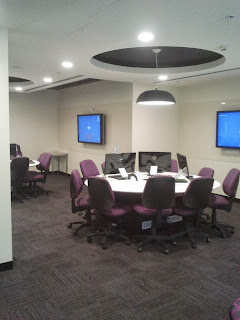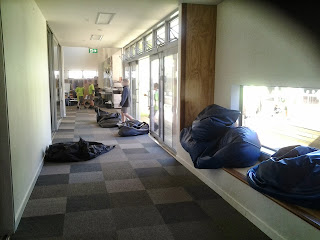 |
The second thing that I notice was how welcoming the staff were and how willing they were to share what they do and answer any questions. I was incredibly grateful to the staff for all they did for me. A program had been put together for me to experience and learn about all aspects of the school. It quickly became apparent that ASMS had a clear vision that infiltrate all aspects of running a school, from the classroom teaching, planning, to professional development.
 |
| Science lab with large glass windows - this enable the teacher to keep an eye on the class outside or the students inside. |
The science lab in the picture is interesting as it can cater for 2 classes. However, when I visited 1 student was in the lab with a tutor and the rest of the class were learning outside the lab but everyone could see everything due to the large glass walls.
You can see from the next 2 photos that the open plan environment is light and spacious. The furniture is about to be replaced and each 'common' will have its own colour.
Teachers plan together not as subject areas but cross curricular. They share the planning and teaching. It was interesting to observe a math class where the two teachers had combined their classes and were working together.
The media room was probably the only room with 4 walls and even one of these was movable. The teacher is quietly innovative. He uses Facebook not just as a communication tool with students but to get the students opinion and guidance from what should be covered, how and what equipment should be used/purchased. He also uses Facebook/twitter to share with students his professional development. This was quite accidental at first. However, students were interested in the fact that their teacher was 'learning' and they were also interested in what he was learning; following the links and participating in the online discussion.
It will take me two posts to cover all they I learnt from visiting this school. But I will leave you with one final photo of me in one of the school flight simulators -amazing that a school has one of these:













